How to Price Aviation Products and Services – a frequent topic of our consulting hours!
Is my product priced too high?
Is that why I’m having trouble making sales?
Should I have a big discount to make more short term sales?These are questions we’re asked in our consulting practice by aviation sales and marketing professionals.
Our answers to these questions, and the reasoning behind them, might surprise you!
Everyone is (rightly) concerned with how to set prices for aviation products and services – there are several theories, and one best answer, most of the time.
[embedyt] https://www.youtube.com/watch?v=WEH61BWHRL8[/embedyt]
Transcript – How to Price Aviation Products & Services
Paula Williams: Welcome to this week’s episode, What Is the Best Pricing Strategy for Aviation Products?
John Williams: Aw, this ought to be interesting.
Paula Williams: So, I’m Paula Williams.
John Williams: And I’m John Williams.
Paula Williams: And we are ABCI, and ABCI’s mission is …
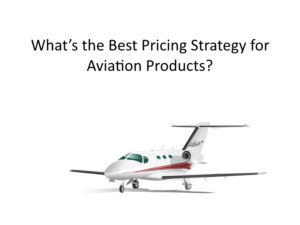 John Williams: To help you ladies and gentlemen out there in the aviation world, sell more products and services. And I’m showing myself to be old, but I still want to say, “Ladies and gentlemen.”
John Williams: To help you ladies and gentlemen out there in the aviation world, sell more products and services. And I’m showing myself to be old, but I still want to say, “Ladies and gentlemen.”
Paula Williams: Okay. You can say that. I’m not going to argue with you. I think it-
John Williams: But it’s inclusive of anybody else who wants to be out there, too.
Paula Williams: Absolutely. Right. We are all of a sudden checking all of our pronouns and everything else, and no disrespect intended for anyone else. But we do like the kind of traditional approach and everything else, but I’m sure we’ll be getting comments on this one. So, that being said, what is the best pricing strategy for aviation products?
John Williams: I think it would depend.
This episode brought to you by . . .
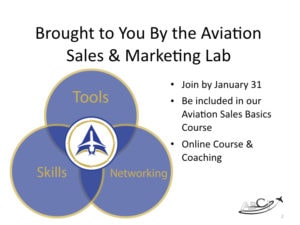 Paula Williams: Yeah. I think so, too, and we’ll be talking about that. That’s a good answer. Okay. So, this is one of the topics that we talked about a lot in our Aviation Sales and Marketing Lab.
Paula Williams: Yeah. I think so, too, and we’ll be talking about that. That’s a good answer. Okay. So, this is one of the topics that we talked about a lot in our Aviation Sales and Marketing Lab.
A lot of our clients want help with pricing, positioning their products, and things like that, looking at how their product fits into the map of their competitive landscape, all of those things. And so, a lot of times in people’s office hours, that’s what we do is talk about how to set the best price for their product.
The “Four Ps”
John Williams: Back in a day when they were teaching marketing in the old school whereas the four PS were price, or was it position?
Paula Williams: Product, position, price-
John Williams: Price.
Paula Williams: … and-
John Williams: Performance.
Paula Williams: … performance. Yeah, I think those were it. I’ve seen different variations of that though in different places.
John Williams: Nowadays? Yeah. I know.
Paula Williams: Right. So, people were taking some poetic license with the four Ps, but pricing being a really important one, and this is one that can give your salespeople a whole lot of confidence if they feel like there’s been a lot of thought put into your price and that is the right price for the market. A lot of times, people have a lot of insecurity about, “Is my price too high?” Not much insecurity about, “Is my price too low?”
John Williams: Well, but maybe there should be because the right price doesn’t mean the low price.
Paula Williams: Mm. Yeah. We’re going to talk about that in nauseating detail in just a minute. So, hopefully not nauseating.
About the Marketing Lab
All right, so anyway, about our Sales and Marketing Lab. This is our tools, skills, and networking recipe or formula or lab if we want to be mad scientists about this, the best combination of components that we put together to help people be successful in aviation, sales, and marketing. So, if you join by January 31st, happy new year by the way, then you will be included in our next session of our Aviation Sales Basics Course. And that is really, really, it’s a $499 value, and it’s a really good deal for people who are coming into sales or marketing for the first time from other parts of aviation. Maybe a pilot or a engineer or a-
John Williams: Mechanic.
Paula Williams: … product specialist. Yeah, a mechanic. Whatever you are, if you’re finding yourself doing sales and marketing, it might scare the crap out of you if you haven’t done it before, and this course is for you. Or if you are coming into marketing and you’ve sold real estate or you’ve sold cars or you’ve sold something else and you’ve not sold anything in the aviation industry, this is also for you. So, it really-
John Williams: aviation marketing.
Paula Williams: Right? It helps you put that together in the most positive sort of way so you can use what you got and make up for what you don’t.
John Williams: Yep.
Four Pricing Strategies
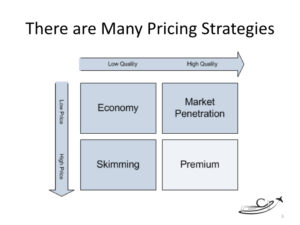 Paula Williams: Right. Okay. Okay. So, there are many pricing strategies, and if you pick up any marketing textbook, you’re going to see things like-
Paula Williams: Right. Okay. Okay. So, there are many pricing strategies, and if you pick up any marketing textbook, you’re going to see things like-
John Williams: The quadrants.
Paula Williams: … this. Right. The pricing quadrants, where you’ve got the low quality versus high quality, the low price versus high price. You’ve got different strategies in there.
Economy Pricing
The economy pricing, of course, is where you do the lowest possible price. In order to do that though, you often have to cut corners on your quality, so you end up with a low-quality product as well. So, that’s the Walmart pricing model, right? Low prices every day. Okay.
John Williams: Well, it’s not just them, but that approach.
Paula Williams: Right. If we go low quality and high price, that’s what we call a skimming model where you’re taking the best possible clients. You can usually only do that once though before they figure out that your product is low quality.
John Williams: Yep.
Skimming
Paula Williams: Okay. And that would be things like the … If you watch late night TV, they have these infomercials about products that are maybe not the best quality, but it’s the first time they’ve been on the market, and nobody’s ever thought of this particular way to trim your cat’s nails before. And so, it’s innovative and everything else, and so they sell a lot of them at a really high price before everybody else gets into the market and they start improving on the product and it shows up in stores. Not sold in stores. That’s usually a pretty good indication of skimming, right?
John Williams: Yes.
Paula Williams: Okay. I think that’s probably the worst strategy for aviation.
John Williams: Oh. That would just put you out of business very soon.
Market penetration – using a “loss leader”
Paula Williams: Exactly. Okay. And then, we go back to the quadrants, and we go to low price, high quality. Sometimes people will do this with what we call a loss leader or something like that where if you have a gateway drug to your particular product or service.
This fits into how to price aviation products – like a discovery flight for a flight school, something along those lines. You want to make that … You okay? Okay. You want to make that a super high-quality experience at the lowest possible price because you know that that person will likely become a customer. And if you’re really good at doing those, then you can do that market penetration pricing on some of your products and services. If you did it on everything, you’d got a business though.
John Williams: Right.
Premium pricing
Paula Williams: Okay. And then, what’s leftover is high quality and high price, and that’s what we call a premium pricing strategy, right?
John Williams: What kind of blurs this is the notion these days that the middle class is … it’s not going away. It’s reducing.
Paula Williams: Right.
John Williams: And some of the groups that we are members of marketing wise say that you either have to go all out for the low end of the market or all out for the high end of the market and forget the middle.
Paula Williams: Mm-hmm (affirmative), right. So, you’ll do really, really well if you are a Walmart and you’re going for the low price and low quality and you’ve got the economies of scale to do that. There’s not many situations like that in aviation.
John Williams: Not that … No. I can’t think of any.
Paula Williams: Right. So, most often if we had to say, “This is the strategy that we recommend most often,” it’s a premium pricing strategy.
John Williams: Absolutely.
Paula Williams: Yeah.
John Williams: And we’re going to talk about that.
Which pricing strategy is best for aviation?
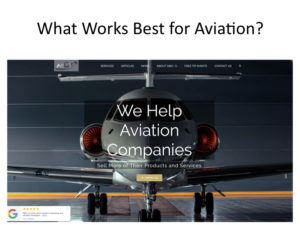 Paula Williams: Yeah, absolutely. We’ve got a lot of means and methods to do that. So, which works best for aviation? It is almost always a premium quality, and we’re not talking about airline tickets. We’re talking about business-
Paula Williams: Yeah, absolutely. We’ve got a lot of means and methods to do that. So, which works best for aviation? It is almost always a premium quality, and we’re not talking about airline tickets. We’re talking about business-
John Williams: No.
Paula Williams: … aviation, general aviation, civil aviation, military aviation, even if you sell products and services to the military. Those kinds of things, you don’t necessarily want to go for the economy pricing model, right? You want to make sure that your products are super high quality, which kind of precludes that whole idea.
John Williams: Uh-huh (affirmative).
Paula Williams: Okay. So, I have a story-
John Williams: Uh-oh.
A story – why premium pricing is the best default strategy
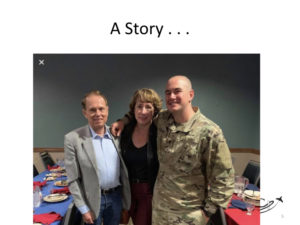 Paula Williams: … exploiting my child for marketing purposes. This is Mickey. He’s the bald one in the picture. Right now, he’s at Fort Benning at Officers’ Training School and OCS, and he was given just recently a list of gear to buy, right? And the list had a range of different options that people could choose, and this whole list would cost you … And this is clothing, camping gear, other kinds of things that they’re going to need while they’re doing the OCS program, right?
Paula Williams: … exploiting my child for marketing purposes. This is Mickey. He’s the bald one in the picture. Right now, he’s at Fort Benning at Officers’ Training School and OCS, and he was given just recently a list of gear to buy, right? And the list had a range of different options that people could choose, and this whole list would cost you … And this is clothing, camping gear, other kinds of things that they’re going to need while they’re doing the OCS program, right?
John Williams: I mean where else can you go where somebody will give you money to go buy camping gear to go out and camp and have a good time?
Paula Williams: Right. Well, they didn’t give them money. They actually had to spend their own, but they are getting paid.
John Williams: They get reimbursed.
Paula Williams: Right. That’s true. So, they have some options in here. They can spend anywhere between 600 and $1,000 to buy this whole list of stuff, right?
John Williams: Mm-hmm (affirmative).
People tend to have higher expectations and confidence in high priced items
“Given all of that information or that lack of information, what I did was bought the top of the line of every item going down the list.”
Paula Williams: But they don’t have a whole lot of time to research: What’s GORE-TEX? What is … I mean, what are all the reasons that I would spend more rather than less for any particular item on this list? So, the options for all of the items on this list, and this included everything from socks to sleeping bags to all of their clothing, all of their outdoor gear, everything else. They didn’t have any time to research the options. They just had to go to the PX and-
John Williams: So, in other words, you’re going to spend $600, or if you go the high end, you’re going to spend a grand.
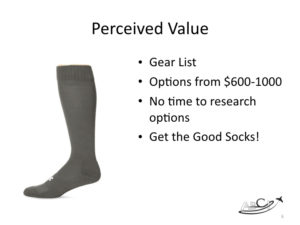 Paula Williams: Exactly. So, given those choices and given the fact that you only want to do OCS once. It is not the world’s most fun experience, right? And it’s a competitive situation. So, the better you do in this environment, the more options you’re going to have in the future. This is a really important time to not have a blister or not have a sprained ankle or not have whatever happened to you. So, if you can invest in better equipment, that’s better, right?
Paula Williams: Exactly. So, given those choices and given the fact that you only want to do OCS once. It is not the world’s most fun experience, right? And it’s a competitive situation. So, the better you do in this environment, the more options you’re going to have in the future. This is a really important time to not have a blister or not have a sprained ankle or not have whatever happened to you. So, if you can invest in better equipment, that’s better, right?
John Williams: It’s better for the body.
Paula Williams: Right, exactly. So given those examples, I was talking to Mickey the other day on the phone, and he’s just like, “Given all of that information or that lack of information, what I did was bought the top of the line of every item going down the list.” And I totally, as a mom, I’m totally on board with that. I think that’s a really smart strategy because you do not want the equipment to be the reason that something doesn’t work out for you.
John Williams: Exactly.
Paula Williams: Right. So, get the good socks every single time, and a lot of people in aviation came from the military.
John Williams: Well, and we do that for your corporate equipment as well.
Paula Williams: Right. We buy really good equipment, and we don’t buy it very often. So, this microphone is 40 years old at least?
John Williams: It was built ’47.
Paula Williams: Okay.
John Williams: So, it’s 60-plus years old.
Paula Williams: Exactly. My computer is six years old. But we bought at the top of the line thing that could be bought at that time, and we keep it forever. All of our vehicles we keep forever. All of our aircraft, we keep forever when we can. So, all of those things are at top of the line, and I think a lot of aviation people have that same mindset.
John Williams: Mm-hmm (affirmative).
High perceived value – What’s wrong with this forty-dollar Rolex?
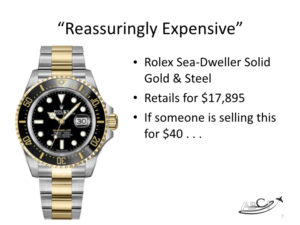 Paula Williams: Here’s another example. This is a Rolex Sea-Dweller solid gold and steel watch, right?
Paula Williams: Here’s another example. This is a Rolex Sea-Dweller solid gold and steel watch, right?
John Williams: It’s a picture of one anyway.
Paula Williams: It’s a picture of one. That’s true. Okay. We don’t actually have one. But anyway, nice watch, very, very nice watch. It retails for $17,895 right?
John Williams: Mm-hmm (affirmative).
Paula Williams: So, if you happened across someone who is selling one for $40, what would you say?
John Williams: Run.
Paula Williams: Exactly. You know that there’s something-
John Williams: You mean-
Paula Williams: Your first-
John Williams: … if they’re selling it as new for 40 bucks?
Paula Williams: Or not. Even if they’re selling it as used for 40 bucks.
John Williams: Yeah, no.
Paula Williams: Your first thought is, “Is it stolen?” Right?
John Williams: Mm-hmm (affirmative). Or, “Is it real?”
Paula Williams: “Is it real?”
John Williams: A lot of knockoffs out there.
Paula Williams: “Is it broken?”
John Williams: Right.
Why do I buy name-brand aspirin?
Paula Williams: There’s something wrong with it. There must be some reason that this is the price that it is. So, there is a concept called Reassuringly Expensive, and it’s the same thing when I go buy aspirin. The Food and Drug Administration says that aspirin has to be aspirin, right? It is the exact same chemical formula whether you buy the store brand or whether you buy Bayer Aspirin.
John Williams: Right. Or the-
Paula Williams: The name brand.
John Williams: Yeah, the name brand or whatever the knockoff version is.
Paula Williams: Exactly. I will always buy the name brand even though there is no logical reason for me to do so. I still feel reassured knowing that this name brand is a good thing in some way. They’ve invested a lot in their name and their reputation, and I feel better about giving my family or whomever an aspirin that is a Bayer Aspirin as opposed to a store brand aspirin.
John Williams: Mm-hmm (affirmative).
Paula Williams: Logical or otherwise, we have that bias.
John Williams: Same thing when you have your car repaired. Do you go with aftermarket stuff or OEM?
Paula Williams: Mm-hmm (affirmative), and OEM is always more expensive.
John Williams: It’s always more expensive, and most of the time, you get what you pay for.
Paula Williams: Mm-hmm (affirmative).
John Williams: But if you don’t pay for it, you certainly don’t get it.
Business aviation consumers are value-minded, but not bargain shoppers.
Paula Williams: Right, exactly. So, those things being said, a lot of salespeople kind of fall into the feeling that everybody’s a bargain hunter and everybody’s going to go for the lowest price. That is not necessarily true. I think a lot of aviation people are programmed the opposite way, or at least our biases are the opposite.
John Williams: Yeah. The interesting thing is airline tickets, because that’s what they based everything on, this everybody wants the cheapest ticket. So, you get a cheap ticket, then they add on for this. They add on for that. Then by the time you get done, it wasn’t the cheapest ticket anyway.
Paula Williams: Exactly, and I think people that buy airline tickets are not the same market that we’re talking about here.
John Williams: No, they’re not.
Paula Williams: Okay.
John Williams: I’m just example.
Price high and justify. Make it worth more than the competitors product.
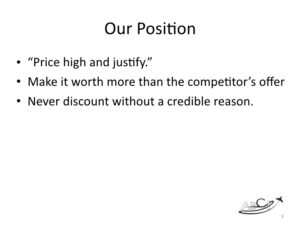 Paula Williams: Yeah, exactly. Okay. So, our position most of the time, not knowing anything else, usually is to price high and justify, right? And that’s a nice little rhyme that we use so that it’s easy to remember price.
Paula Williams: Yeah, exactly. Okay. So, our position most of the time, not knowing anything else, usually is to price high and justify, right? And that’s a nice little rhyme that we use so that it’s easy to remember price.
John Williams: Yep.
Paula Williams: Price high and justify. You want to make it worth more than your competitor’s offer.
John Williams: And that’s very important.
Paula Williams: Exactly. The value has to be there. It has to be worth more to your customer in the currency that he uses, which is either time savings or convenience or ease of use or whatever’s important to your customer. It has to be worth more than your competitor’s offer. We also advocate to never, never discount your price without a credible reason.
John Williams: And it can’t be a discount forever.
Paula Williams: Exactly.
John Williams: It’s a discount for some amount of time.
Paula Williams: Mm-hmm (affirmative).
John Williams: And the reason’s got to be there, and it’s got to be something the potential buyer grasps without even thinking about it.
Paula Williams: Yeah, that passes the smell test, you know?
John Williams: Right.
Paula Williams: It’s last year’s model, or it is something where you’ve got a temporary advantage in your market. Or you’re starting a new partnership with someone, and you shop throwing in a joint offer or something of that nature where you’re testing out market testing a new product. Some reason that it will be less expensive because otherwise, you’re losing your integrity or your price integrity.
John Williams: And you’ll never get it back.
Paula Williams: Right. And you look at Apple and some of the other companies that have really good cost integrity, and you will never see their products discounted without a really good reason, like-
John Williams: And this-
Paula Williams: … the next version just came out and so the-
John Williams: Well, but-
Paula Williams: Yeah.
John Williams: So, some of the aftermarket sellers of Apple products may price it down, but they’re taking the hit.
Paula Williams: Oh, yeah.
John Williams: Apple’s not.
Clearly & consistently communicate value.
 Paula Williams: Right. And Apple may not have control over what some of the aftermarket folks do, but you will never see an Apple product reduced in price or discounted without a really good reason. Right? Okay.
Paula Williams: Right. And Apple may not have control over what some of the aftermarket folks do, but you will never see an Apple product reduced in price or discounted without a really good reason. Right? Okay.
So, the other thing about this is that you have to very clearly communicate the value of whatever it is that you’re offering, and you have to be able to express that in a way that people will understand so that they get it. And you can put it into a sentence.
Use similes & metaphors
You can put it into a metaphor. One of my favorite metaphors is like your computer system that’s like a warehouse. It’s you can go in and you can find what you need more easily and things like that. Rather than talking about all of the components of the software, you talk about why it is useful. Why is this more valuable to your customer? How much time is it going to save them? How much money is it going to save them? What opportunities is it going to give them that they didn’t have before? So, you want to make sure that whenever you talk about your product, you can clearly communicate that value.
John Williams: And that started with IBM.
Paula Williams: Right, exactly. Another way to do that is to be consistent in your branding. So, if you’re selling that Rolex on a street corner and you’re wearing a trench coat, your branding is not consistent with Rolex. So, you’ve got a cognitive dissonance going on in your customer’s mind. Was that too nerdy? That was really nerdy. Let me try that again.
Okay. So, if you are selling a really expensive product and you show up doing a teleconference dressed in your pajamas and it looks like you’re in your parents’ basement, that is cognitive dissonance, and that means you’re not showing up in a way that represents an expensive product.
John Williams: Right.
Paula Williams: Okay. So, what the way that you answer the phone. Do you sound like a company that gets paid hundreds of thousands of dollars for your product or service?
John Williams: Mm-hmm (affirmative).
Don’t give any “cheap signals”
Paula Williams: If yes, great. If not, you’ve got a cognitive dissonance problem and you’ve got an inconsistency problem, and you’re not communicating value. What you wear to work. If you are showing up in flip flops and you are selling a fantastic product that is worth a lot of money, then again, you’re not communicating that value.
John Williams: No.
Paula Williams: Unless it is a pool party, in which case you were very expensive flip flops, right?
John Williams: And we’ve been to one of those.
Paula Williams: Right? Exactly. It’s just like, “Okay.” Or we’ve had clients that say, “I’m going to a pool party with my customer, and I want to show up dressed appropriately.” In that case, we throw them on the mercy of the retail industry and whatever communicates that best. So, costuming is important. The way you speak is important. All of that stuff has to be in line so that everything matches, right?
John Williams: Yeah, and you can show up unkempt to a sales meeting, and you may make a sale.
Paula Williams: Mm-hmm (affirmative).
John Williams: But you’re making the company look bad.
Paula Williams: Well, you’re working against that consistency, right?
John Williams: Yep.
How to price aviation products – Make sure the entire customer experience is premium.
Paula Williams: So, everything that you can do to add to that consistency and communicate that message and communicate, “We are the best. We really respect you. We’re going to dress up when we show up. We are going to answer the phone promptly, and we’re going to take care of you.” All of those things were in line with what people expect from somebody that they’re going to spend a lot of money with.
John Williams: Mm-hmm (affirmative).
The Aviation Marketing Lab
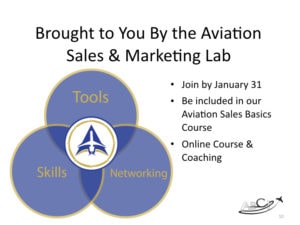 Paula Williams: Okay. All right. So, to clearly give you an example of how we communicate value, our Sales and Marketing Lab is a $279 investment or $179 investment per month that has more than 10 times that value in terms of the software, the tools, the networking, and everything else. In fact, if you join by January 31st, you also get our Sales Basics Course, which is an online course that has a retail value of 499. A lot of people who’ve taken it at 499 and loved it.
Paula Williams: Okay. All right. So, to clearly give you an example of how we communicate value, our Sales and Marketing Lab is a $279 investment or $179 investment per month that has more than 10 times that value in terms of the software, the tools, the networking, and everything else. In fact, if you join by January 31st, you also get our Sales Basics Course, which is an online course that has a retail value of 499. A lot of people who’ve taken it at 499 and loved it.
John Williams: Mm-hmm (affirmative).
Paula Williams: So, that’s a really good opportunity for you to learn your sales skills and be able to present that value in a way that makes sense. And one of the other things that we do in that course is to rehearse your sales presentation-
John Williams: Yep.
Sales tools have changed!
Paula Williams: … and do sales calls and things like that so we can help you improve your video conferencing skills if that’s the way that you’re selling these days, and a lot of people are. A lot of people are new to video conferencing or just plain old sales calls, your direct mail, your other things, ways that you present your product or service, webinars, and stuff.
John Williams: How you prepare-
Paula Williams: Yes.
John Williams: … for the call before you make it.
Paula Williams: Exactly. So, you can join our online. It’s an online course with coaching included in that, so it doesn’t matter what your schedule is or how that all works. We’ll find a way to make it work for you. And we work with people all over the world and help them to hone their sales skills, right?
John Williams: Yes, we do.
Go sell more stuff. America needs the business!
 Paula Williams: Okay. So, go sell more stuff.
Paula Williams: Okay. So, go sell more stuff.
John Williams: Yep. “America certainly needs the business.” The more of it we make, the better we are.
Paula Williams: Absolutely.
John Williams: Zig Ziglar.
Paula Williams: Yep. We love Zig most of the time. Thanks for joining us, and we’ll see you next week.
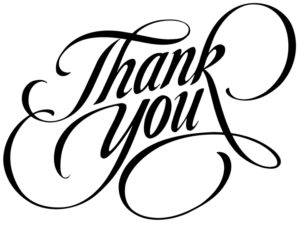 John Williams: See you next time.
John Williams: See you next time.
Podcast: Play in new window | Download
Subscribe: Spotify | Amazon Music | RSS
